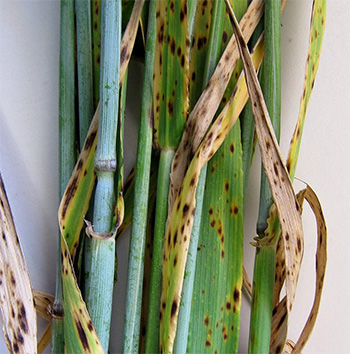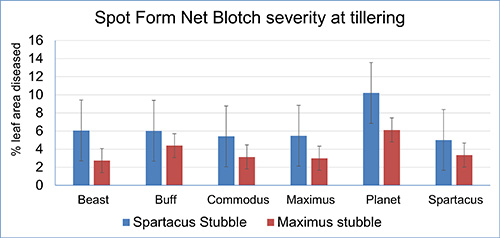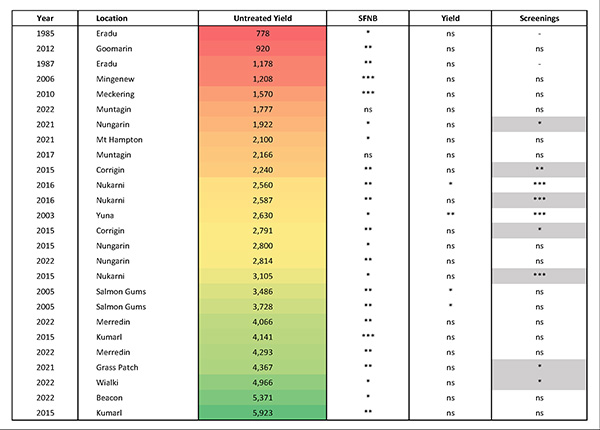Paddock Practices: Variety selection key to controlling SFNB in low-rainfall barley
Paddock Practices: Variety selection key to controlling SFNB in low-rainfall barley
Date: 30 Nov 2023

Selecting the right variety can significantly reduce the impact of spot form net blotch (SFNB) and optimise economic returns in the barley intensive cropping systems prevalent in Western Australia’s low-rainfall zone (LRZ).
This is one of the key findings from data collected by Department of Primary Industries and Regional Development, Western Australia (DPIRD) plant pathologists working on a five-year GRDC investment, Management of spot form of net blotch in the low-rainfall zones of Western Australia.
With new varieties offering improved yield potential and useful disease resistance, barley growers are encouraged to update their variety choice for 2024 to reduce disease risk.
Spot form net blotch
SFNB is an important disease of barley across all cropping regions of WA. It is caused by the fungal pathogen Pyrenophora teres f. maculata, which survives on infected stubble.
In the LRZ, barley-on-barley rotations and high inoculum loads on barley stubble from previous seasons create favourable conditions for infection. Susceptible barley varieties, early sowing, mild temperatures (15-25 degrees Celsius) and regular leaf wetness can also encourage disease outbreaks.
Susceptibility drives infection
As part of the project, DPIRD researchers conducted four field trials at Muntadgin, Nungarin (two sites) and Merredin during 2021 and 2022. These were planted with the region’s leading variety, Spartacus CL, and its likely replacement Maximus CL. At seedling stage, Spartacus is rated susceptible (S) and Maximus moderately susceptible (MS) to SFNB, while as adult plants Spartacus is rated as susceptible-very susceptible (S-VS) and Maximus is rated as moderately susceptible-susceptible (MSS).
DPIRD research scientist Jason Bradley says Maximus showed significantly lower rates of canopy infection than Spartacus, while Spartacus left higher rates of carry-over infection in its stubble (Figure 1).
“At our Merredin site we planted replicate variety trials over blocks of Maximus or Spartacus stubble and found the Spartacus stubble notably increased disease pressure on the following season’s seedlings,” he says.

Unreliable returns from fungicide
In fungicide trials, foliar treatments reduced SFNB compared to untreated control plots, however there were no significant yield benefits as a result.
“With greater genetic resistance to SFNB, Maximus out-yielded Spartacus by 5 to 23 per cent across the treated and untreated plots,” Mr Bradley says.
“There was a benefit in grain size, with some fungicide treatments increasing retentions over a 2.5 millimetre sieve by 8.5 per cent for Spartacus and 3.4 per cent for Maximus.
“Screenings could also be improved – sometimes raising Spartacus to malting grade when it had not met specifications, while Maximus grain was generally malting grade with or without fungicide treatment.”
Further to these trials, DPIRD research scientist Andrea Hills has conducted a meta-analysis of 26 barley trials conducted across WA over the past 20 years, including 20 trials in the LRZ.
Using foliar fungicide to control SFNB delivered a statistically significant yield benefit in only four of the 26 trials analysed. Grain screenings were reduced in nine of the trials (Table 1).

The project team has also investigated use of a fungicide seed treatment (Systiva®) to reduce the need for foliar fungicide to control SFNB. While the seed treatment helps reduce early SFNB infection, a yield response was not consistent, similar to foliar applications.
Agronomic methods are the preferred strategy in mitigating SFNB foliar disease infection, particularly as there is a risk of developing fungicide resistance.
In low rainfall environments, the use of fungicides to control SNFB was found to be an unreliable strategy with a low likelihood of economic benefit, even in years with good yield potential.
Disease carry-over drives infection
Mr Bradley says stubble-borne inoculum is the main driver of SNFB in LRZ cropping systems.
“While planting barley into barley stubble is never ideal, we know it is a practice for some growers” he says.
“However, the repeated use of susceptible varieties allows inoculum to proliferate and infect the following season’s crop.”
He says the trials at Merredin showed that even a small increase in genetic resistance can have a significant impact on disease severity and levels of inoculum carry-over.
“Planting a more resistant barley sets up a positive feedback loop where infection is reduced in-season, which reduces the stubble-borne inoculum at seeding, which reduces disease pressure in the following season – and so on.
“The indications are that genetic resistance can drive inoculum levels down to a point where SFNB is more likely to only be an issue in wetter seasons.
“Based on our stubble and fungicide trials, the project has demonstrated the value of variety choice in saving growers the cost of buying and applying fungicides, without fear of a yield penalty.”
Next steps
The Management of spot form of net blotch in the low rainfall zones of Western Australia investment will continue to investigate some key areas of SFNB management for LRZ producers over the next two years.
One important knowledge gap relates to the rates of barley stubble breakdown and period of inoculum survival on stubble under typical LRZ conditions. Evidence from high rainfall environments is that SFNB inoculum survives on barley stubble for up to two years after an infected crop has been harvested. Research is underway to determine the longevity of this risk factor in low rainfall areas.
As part of the investment, researchers will also conduct a detailed economic analysis to quantify the costs of using fungicide to control SNFB, compared to the savings and yield implications of managing the disease through agronomic strategies such as variety choice.
This could help establish valuable decision-making guidelines – especially in the context of likely drier growing seasons, sustained demand and positive grain prices.
Use variety choice for disease control
In the meantime, the evidence strongly suggests choosing a more resistant barley variety is the best way for growers to reduce infections, fungicide costs, fungicide resistance risk and disease pressure from infected stubble.
DPIRD’s 2024 Western Australian Crop Sowing Guide provides up-to-date information on several new barley varieties, including their SFNB resistance ratings, yield potential and suitability for conditions in the LRZ, for growers to consider.
Further reading
Economical management of Spot form net blotch in low rainfall environments: using less susceptible varieties makes sense. DPIRD, Protecting WA Crops, May 2023
2024 Western Australian Crop Sowing Guide
Australian Fungicide Resistance Extension Network
More information
Jason Bradley, DPIRD
e. [email protected]
This Grains Research and Development Corporation (GRDC) paddock practices article was produced with input from the Department of Primary Industries and Regional Development (DPIRD) in WA as part of the GRDC investment Management of Spot Form Net Blotch in the Low Rainfall Zones of WA.
GRDC Project Code: DAW2104-001RTX,
